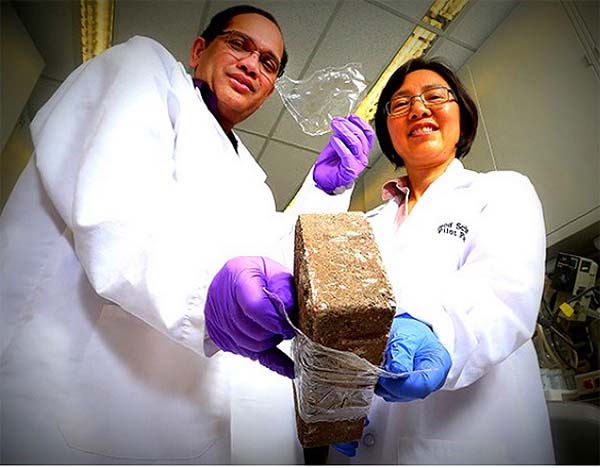Purdue Researchers Find New Use for Cellulose
![]() Print this Article | Send to Colleague
Print this Article | Send to Colleague
Purdue University (Lafayette, Ind., USA) researchers have developed tough, flexible, biodegradable films from cellulose, the main component of plant cell walls. The films could be used for products such as food packaging, agricultural groundcovers, bandages, and capsules for medicine or bioactive compounds.
Food scientists Srinivas Janaswamy and Qin Xu engineered the cellophane-like material by solubilizing cellulose using zinc chloride, a common inorganic salt, and adding calcium ions to cause the cellulose chains to become tiny fibers known as nanofibrils, greatly increasing the material’s tensile strength. The zinc chloride and calcium ions work together to form a gel network, allowing the researchers to cast the material into a transparent, food-grade film.

Pictured above: Food scientists Srinivas Janaswamy and Qin Xu hold a brick atop the biodegradable film they produced from cellulose, the main component of plant cell walls.
"We’re looking for innovative ways to adapt and use cellulose—an inexpensive and widely available material—for a range of food, biomedical and pharmaceutical applications," said Janaswamy, research assistant professor of food science and principal author of the study. "Though plastics have a wide variety of applications, their detrimental impact on the environment raises a critical need for alternative materials. Cellulose stands out as a viable option, and our process lays a strong foundation for developing new biodegradable plastics."
Cellulose’s abundance, renewability and ability to biodegrade make it a promising substitute for petroleum-based products. While a variety of products such as paper, cellophane, and rayon are made from cellulose, its tightly interlinked structure and insolubility—qualities that give plants strength and protection—make it a challenging material to work with.
Janaswamy and Xu loosened the cellulose network by adding zinc chloride, which helps push cellulose’s closely packed sheets apart, allowing water to penetrate and solubilize it. Adding calcium ions spurs the formation of nanofibrils through strong bonds between the solubilized cellulose sheets. The calcium ions boost the tensile strength of the films by about 250%.
The production process preserves the strength and biodegradability of cellulose while rendering it transparent and flexible.
Because the zinc chloride can be recycled to repeat the process, the method offers an environmentally friendly alternative to conventional means of breaking down cellulose, which tend to rely on toxic chemicals and extreme temperatures.
"Products based on this film can have a no-waste lifecycle," said Xu, research assistant professor of food science and first author of the study. "This process allows us to create a valuable product from natural materials—including low-value or waste materials such as corn stover or wood chips—that can eventually be returned to the Earth."
The methodology could be adapted to mass-produce cellulose films, the researchers said.
The next step in the project is to find ways of making the cellulose film insoluble to water while maintaining its ability to biodegrade.
Janaswamy and Xu have filed a technology disclosure agreement with the Purdue Office of Technology Commercialization.
Purdue graduate student Tianming Yao and then-undergraduate students Chen Chen and Katelyn Rosswurm also contributed to the research.
Financial support for the research came from the John and Emma Tse Gift Fund for Experimental Research on Cellulosic Ethanol and Biomass through the Li Fu Chen Memorial Laboratory Fund, the Marin Undergraduate Research Fund Scholarship from Purdue Agricultural Research Programs, and the Purdue Whistler Center for Carbohydrate Research.


